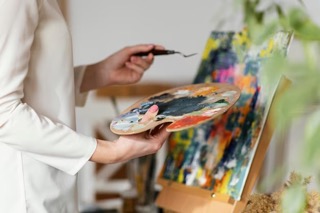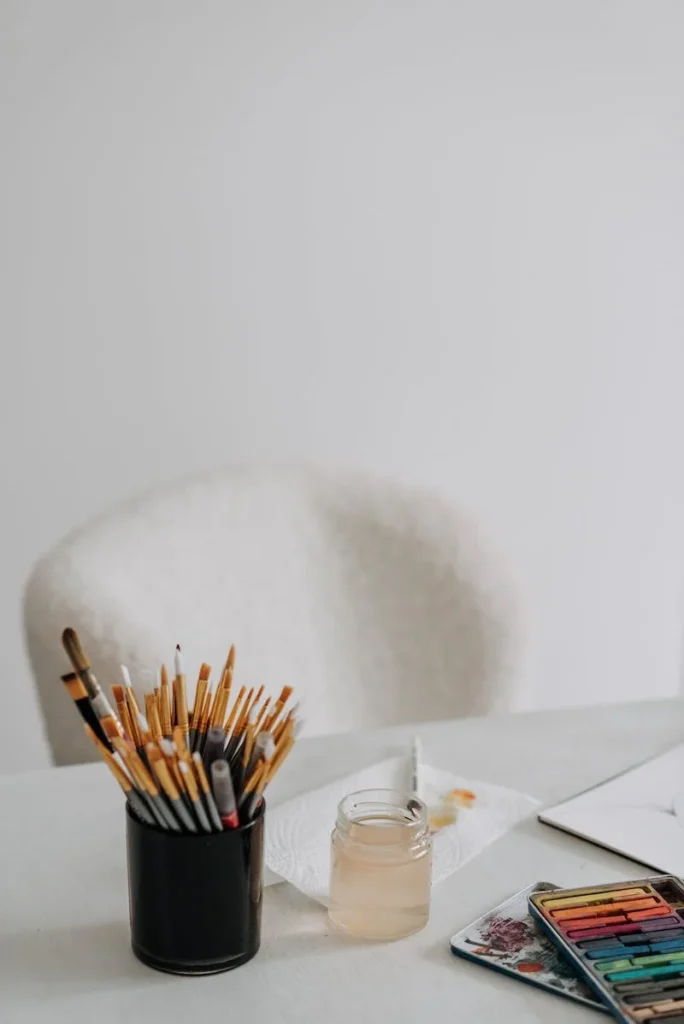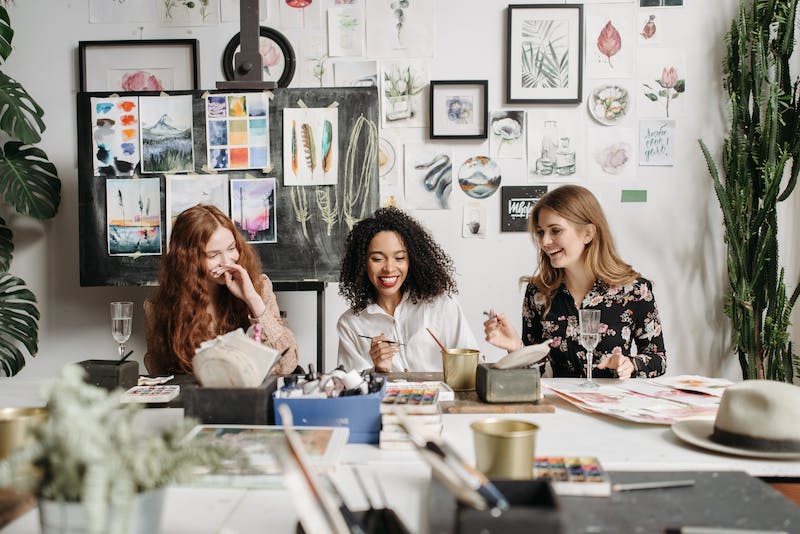Expressive Arts Therapy
The Art of Healing through Drawing and Painting
As we explore the transforming impact of painting and sketching on emotional well-being, let your emotions run wild, your soul find peace, and your creativity flourish. It’s natural to feel a spectrum of emotions in the fast-paced world of today. But what if all you needed was a blank canvas and a brushstroke to provide clarity and comfort? The tremendous effects of creative expression on mental and emotional health are explored in depth in this article.
People may traverse and process complicated emotions with the help of paintbrush strokes or pencil lines, which can result in a sense of catharsis and inner serenity. No matter how experienced you are, making art may serve as a type of meditation that promotes attention and lowers stress. Furthermore, the artistic expression of one’s emotions may be a potent instrument for reflection and personal development as well as a priceless source of psychological insights.
The Therapeutic Benefits of Drawing and Painting
Creating art through sketching and painting has many therapeutic advantages that support mental health. One can achieve a state of flow, in which the mind is totally absorbed in the here and now, by concentrating on a creative endeavor. This immersion in the creative process may release the weight of intense emotions and bring about a sense of clarity and tranquility. Working with art supplies may also be a calming tactile experience that offers a sensory outlet for releasing and expressing emotions.
People may externalize their feelings and experiences via art in a certain way. When words can’t express how deeply one feels, art may be a very effective tool for communication. A person’s emotional landscape may be distilled into a visual narrative via the use of color, form, and arrangement. People can acquire a sense of agency and control over their emotions by externalizing internal experiences, which fosters a stronger sense of empowerment and well-being.
Additionally, painting and sketching may help people feel good about themselves and accomplished. Whether it’s a straightforward drawing or a colorful painting, the process of making something from nothing may make one feel proud and satisfied.
How Art Can Impact Emotional Well-Being
Beyond the process of production itself, art has a profound effect on emotional health. Thinking about and appreciating art may elicit strong emotional reactions and be a source of inspiration, solace, and reflection. People are given the chance to experience empathy and validation when they interact with art that speaks to their emotions; this promotes a feeling of connection and understanding.
A vast range of feelings, from happiness and calm to reflection and insight, may be evoked by art. People might take comfort in the universality of human emotions and get perspective on their own sentiments by immersing themselves in artworks that depict a variety of emotional experiences. Moreover, the process of analyzing and pondering art may arouse mental and affective responses, fostering an inquisitive and introspective spirit.
Another way that art facilitates emotional release and expression is as a catalyst. Making art may give those who might find it difficult to communicate their feelings vocally a non-verbal means of doing so. It is possible to articulate complicated feelings with this nonverbal communication style that would not be possible through other means. People can access and resolve deep-seated emotions via the act of producing or experiencing art, which can result in catharsis and a sense of emotional release.

Drawing and Painting as a Form of Self-Expression
Painting and drawing provide a special means for people to express and discover their inner selves. People may express and make sense of their emotional landscapes by externalizing their thoughts, feelings, and experiences via the act of producing art. Through symbolic images, figurative representations, or abstract forms, art offers a visual language for expressing the indescribable facets of human experience.
Language and cultural boundaries are irrelevant when it comes to artistic expression, which provides a common language that appeals to the emotions. Through the use of visual symbolism, people may communicate the subtleties of their emotional states so that others can relate to and comprehend their inner world. This type of self-expression encourages others to participate in sympathetic conversation, which strengthens feelings of emotional connection and understanding between people. It also helps individuals feel more authentically themselves.
Furthermore, the process of expressing oneself artistically can promote a sense of agency and independence. Individuals demonstrate their ability to construct and share their emotional narratives by taking ownership of their creative process. This empowerment, which offers a forum for self-advocacy and self-assertion, may be especially helpful for people who might feel silenced or excluded in other areas of their lives.
Art Therapy and Its Psychological Benefits
Using the natural therapeutic qualities of art, art therapy helps people achieve psychological and emotional recovery. People use the process of making art as a way to explore, comprehend, and resolve emotional and psychological difficulties under the supervision of a qualified art therapist. Art therapy provides a secure and encouraging atmosphere for people to explore their inner selves and strive towards emotional development and integration via planned art-based exercises and introspective conversation.
Art therapy is a valuable psychological tool that may help with emotional expression and processing. People may externalize and analyze their emotions in a safe and concrete way through art, which gives them a tangible outlet to explore their inner experiences. Through the process of producing art in a therapeutic setting, people may access and process feelings that they might find challenging to express in typical talk therapy, which can result in a better awareness of their emotional terrain.
Additionally, art therapy fosters insight and self-awareness. Through participating in the creative process and analyzing the final artwork, people may learn a great deal about their feelings, mental processes, and interpersonal dynamics. Engaging in self-reflective practises can facilitate the development of adaptive coping skills and a stronger sense of self-awareness, ultimately improving emotional resilience and overall well-being.
Moreover, art therapy can help people connect the disconnected parts of themselves. People can externalize and resolve competing emotions, memories, or identities via art-making, which enhances one’s feeling of completeness and coherence. For those who have gone through trauma or emotional suffering, this integration process may be very helpful as it provides a road to recovery and repair.
Tips for Using Drawing and Painting for Emotional Healing
Integrating drawing and painting into one’s self-care routine can be a powerful tool for emotional healing and well-being. Here are some tips for leveraging the therapeutic potential of art:
- Create a Sacred Space: Set aside a room that is only for your artistic pursuits, free from outside influences and supportive of reflection and creation. This area can function as a haven for the discovery and expression of emotions.
- Engage in Mindful Art Practices: Approach the process of sketching and painting mindfully, paying attention to the feelings, motions, and sensations that come with it. As you immerse yourself in artistic expression, embrace the present.
- Explore Different Art Materials: Try your hand at using different art media, such watercolors, pastels, charcoal, or mixed media. Diverse materials provide a range of opportunities for self-expression by evoking different sensory experiences and emotional reactions.
- Journaling and Art Integration: To develop a comprehensive strategy for emotional expression, include journaling with painting and sketching. To develop more self-awareness, use writing as a tool for reflection on your creative works and the feelings they arouse.
- Seek Art Communities and Resources: Participate in workshops, art communities, and other resources that address the relationship between art and mental health. Making connections with people who share your interests may provide you inspiration, encouragement, and a feeling of community.
- Embrace Imperfection: Let go of the need for perfection and see the creative process as a quest for personal growth. Give yourself permission to try new things, fail, and gain knowledge from the expressive potential of art.

Exploring Different Art Mediums for Emotional Well-Being
Drawing and painting encompass a diverse array of mediums and techniques, each offering unique opportunities for emotional exploration and expression. Here are some art mediums and their potential impact on emotional well-being:
- Watercolors: The pursuit of emotional fluidity and transitions is made possible by the fluid and translucent quality of watercolors, which may convey a sense of lightness and spontaneity. The way that colors and water interact may represent the rise and fall of feelings, providing a metaphorical language for expressing feelings.
- Acrylics: Acrylic paints offer a bright, adaptable medium for audacious expression. Acrylics’ tactile qualities can encourage people to project their whole emotional range onto the canvas, enabling expressive and dynamic movements that reflect the complexity of inner feelings.
- Pastels: Gentle and tactile exploration is made possible by the pastels’ velvety, delicate feel. Pastels provide a medium for delicate and personal expressions of mood and are especially useful for portraying the intricacies of emotional subtleties.
- Charcoal: Mark-making may be dramatic and gestural due to the strong and expressive character of charcoal. Drawings made with charcoal may have a sense of rawness and immediacy that makes them a powerful medium for expressing strong feelings and internal turmoil.
- Mixed Media: Using a variety of mediums and techniques, mixed media art may provide a multifaceted means of expressing emotions. People are invited to investigate the interaction of opposing or complimentary feelings when different pieces are layered and juxtaposed, reflecting the complexity of emotional experiences.
Drawing and Painting for Stress Relief and Relaxation
Painting and drawing may be effective ways to relieve stress and anxiety when faced with the challenges and demands of daily life. Engaging in creative production provides a break from the hectic routine of daily life, enabling people to relax, rejuvenate, and find comfort in the healing power of art. Drawing and painting can help with relaxation and stress alleviation in the following ways:
- Art as a Meditative Practice: Painting and sketching may be used to help people enter a state of calm and focused concentration. Similar to mindfulness and meditation, the rhythmic and repeated motions involved in creative production can have a relaxing and centering impact.
- Emotional Release and Catharsis: People can externalize and process tension and pent-up emotions by using artistic expression as a vehicle for these processes. Creating a visual representation of inner turmoil can be a therapeutic process that promotes emotional catharsis and inner serenity.
- Creative Flow and Timelessness: When people are in a creative flow, they feel as though they are fully present and unaffected by the passing of time. Engaging in artistic expression can provide a momentary haven for individuals seeking stress relief and refreshment.
- Sensory Engagement and Grounding: Drawing and painting provide a tactile and sensory break from stress and mental chatter, helping people to stay grounded in the present. The physicality of creative motions and interaction with art supplies can provide a feeling of groundedness and embodied calm.

Art Communities and Support for Emotional Well-Being
Engaging with art communities and support networks can enrich one’s artistic journey and contribute to emotional well-being. The following are ways in which art communities and resources can serve as a source of support and inspiration:
- Peer Connection and Understanding: Art communities offer a forum for people to get in touch with peers who share their enthusiasm for both emotional health and creative expression. Talking with others who value the transformational potential of art may promote understanding and a sense of unity.
- Shared Resources and Learning Opportunities: Art groups frequently provide an abundance of resources, such as seminars, workshops, and instructional materials centered on the relationship between mental health and the arts. By using these materials, one may broaden their creative horizons and get insightful knowledge about the healing power of art.
- Opportunities for Artistic Exploration: Being a part of art groups may lead to joint projects, exhibits, and other creative endeavors that inspire people to experiment and broaden their artistic perspectives. These chances for artistic discovery can provide channels for emotional expression and personal development, as well as revitalize one’s creative practice.
- Validation and Empowerment: People can find confirmation and acceptance for their creative pursuits and personal stories in art communities. Sharing one’s work and experiences with others in a community that is encouraging may help people feel empowered and like they belong, which can boost their self-expression and confidence.
Through the strokes of a brush or the lines on a canvas, I’ve discovered a profound avenue for self-discovery, healing, and emotional release. The act of creating art becomes a therapeutic dialogue with my inner self, a medium through which I can navigate and articulate complex emotions. Personally, the vibrant palette of colors and the freedom to express without judgment have offered solace during challenging times. Drawing and painting have become more than creative outlets; they are dynamic tools for fostering resilience, self-reflection, and an overall sense of well-being. As I encourage others to explore the world of expressive arts therapy, I firmly believe that the canvas is not just a surface for artistic endeavors but a sacred space where emotions are acknowledged, processed, and beautifully transformed.


